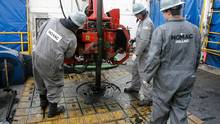Shale oil bonanza to cost refiners billions
 America’s shale oil boom is great news for U.S. industry, jobs and consumers, but it could cost global refiners billions.
America’s shale oil boom is great news for U.S. industry, jobs and consumers, but it could cost global refiners billions.Banking on rising demand for transport fuels, oil companies around the world have committed as much as $100-billion over the last decade on equipment to turn heavy oil into valuable refined products such as gasoline, jet fuel and petrochemicals.
But the investment has coincided with the discovery of vast reserves of high quality oil and gas held in tight rock formations beneath Texas, North Dakota and other U.S. states, which has changed the market – probably forever.
The world’s average crude oil barrel is becoming lighter as new hydraulic fracturing or “fracking” technology and deep horizontal drilling extracts very high quality hydrocarbons.
New U.S. shale provinces are now pumping more than a million barrels per day (bpd) of some of the lightest oil available that is much “sweeter” – containing less of the contaminant sulphur.
And the same technology is soon to be deployed elsewhere in the world, producing more and more light oil.
As supplies increase, the value of light crude oil relative to heavy oil is collapsing and profits from equipment to upgrade heavy crude, such as expensive fluid catalytic crackers (FCCs) and coking units, are falling.
“Companies have invested for a world supplied with heavy and sour crude, but now they find crude is getting lighter and sweeter,” said Stephen George, principal consultant at KBC Process Technology Ltd. in Walton on Thames, England.
“The market is going to be way over-supplied with deep upgrading capacity,” Mr. George said, adding, “Many FCC refineries are … looking dubious.”
Petroleum economists forecast that average margins from the most expensive oil processing plants could fall by 30 to 40 per cent over the next five years as new plants come on stream.
“We are talking about margins being a couple of dollars per barrel worse than we could have expected,” said Jonathan Leitch, senior energy research analyst at consultancy Wood Mackenzie.
“If the assumption two or three years ago was for margins of $5 to $7 per barrel, then it would now be more like $3 to $5,” he said. “If you had been expecting a margin of perhaps $5, you could now be looking at perhaps $3.”
This is bad news for oil companies who have invested a fortune over the last decade in advanced equipment to extract poisonous sulphur and transform viscous oil into liquid fuels.
These plants are not cheap.
Typically $1.5-billion to $3-billion each, the top dozen oil projects commissioned over the last six years cost almost $60-billion alone and there are dozens of other smaller projects.
China’s Sinopec, Total SA, Chevron, BP and Marathon have all invested billions in the hope of adding extra value to oil.
With global oil processing capacity close to 90 million bpd, and rising by about 1 million bpd per year, the loss of even a few cents per barrel in margins hits the oil industry hard.
And analysts see no prospect that the trend towards lighter crude oil will be reversed.
“Looking forward, we can see that globally the crude slate is getting lighter for the next four to five years and this is coinciding with much more upgrading capacity coming on line and an increase in demand for heavy crudes,” Mr. Leitch said.
The pace of change in the oil market has been startling.
As U.S. shale oil output has rocketed over the last year, the United States has dramatically reduced its imports of similar oil from African producers Algeria, Libya and Nigeria, forcing down those export prices.
The value of Algerian Saharan Blend crude oil, one of the best quality crude oils which only a year ago commanded a premium of up to $2 per barrel over North Sea Brent Blend, has collapsed to a discount of more than $2.50.
At the same time the value of heavier crudes, many with high levels of contaminants, and the cost of heavy fuel oils produced from them, have risen, further eroding the logic of investment in complex refining capacity.
In Asia, where demand for gasoline and chemical feedstocks is still rising due to urbanization and rapid industrial development, complex oil processing yields have held up so far.
But in Europe, complex refining margins have already fallen and are likely to drop even more rapidly in the years ahead.
Even in the United States, where refining margins have benefited so far from the extra supply of cheap domestic crudes, complex processing yields will eventually come under more pressure, analysts say.
“All over the world, oil companies will have to re-evaluate their plans for refining capacity,” said Michael Wittner, head of commodities research at Société Générale in New York. “This is a global issue that oil companies have yet to address.”
You can return to the main Market News page, or press the Back button on your browser.

